|
|
| RHP |
South African
River Health Programme
|
State of the Rivers Report
uMngeni River and Neighbouring Rivers and Streams
|
ALBERT FALLS RESOURCE UNIT
|
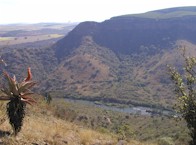
|
Below Midmar Dam, the uMngeni plunges over the 111m high Howick Falls and into the uMngeni Valley where remnants of Midland forest can be seen. The Karkloof tributary then joins before the uMngeni flows into Albert Falls Dam. Approaching Albert Falls, the uMngeni meanders through grassed farmland, where the riverbanks are treeless or invaded by woody alien plants. Below the falls, the river traverses deeply dissected terrain, which forms the western edge of the Valley of a Thousand Hills. At Nagle Dam, the river is still at a high elevation (400m above sea level) despite being a mere 50km from the coast. The main land use types here are forestry in the west and north and cultivated land, especially sugar cane, and feedlots in the Wartburg area. A large part of the area is hot, dry valley bushveld used for subsistence agriculture. The population of the area is only 68 900.
|
|
Water quality in this resource unit is Good although only Fair at iMpolweni.
Riparian habitat in the upper reaches is badly affected by agriculture and forestry although better in the Umgeni Valley Nature Reserve. In the lower bushveld reaches, riparian habitat is Good despite vegetation encroachment into the river channel.
Instream habitat of the Karkloof River is Good and even Natural in the lower reaches. In the uMngeni River, the influence of dams (altered flow pattern and water quality) is noticeable and instream habitat here is only Fair.
Invertebrates of the uMngeni and Karkloof are in Good condition and even Natural in the lower reaches of the latter.
Fish scores show the same trend but reflect the presence of invasive species (trout in the upper Karkloof, and bass at several places). Some indigenous fish are also alien here, like the Mozambique and redbreast tilapia. The fish in the lower uMngeni are only in Fair condition due to the regulation of the river by dams.
|
|
Water releases from Albert Falls Dam are particularly "unnatural" as flows tend to be highest in the dry winter months, and low during summer. This flow pattern can disrupt ecological processes (see p.30). At Nagle Dam, bypass gates can be used to mimic a more natural flow pattern.
|
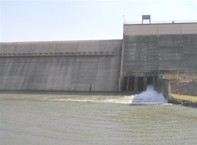
|
|
A considerable portion of the Albert Falls and Nagle catchments (in the upper reaches) are under plantation forests and invasive alien trees which reduce the flow of water to the river.
Cattle feedlots below Albert Falls Dam introduce excess nutrients to the river system.
Effluent discharges from Howick impact on the uMngeni River. Considerable impacts also emanate from the iMpolweni area where poor land management and inadequate sanitation contribute to turbid, nutrient-rich waters.
|
|
Tourism and recreation especially around Howick Falls, is based largely on and around the river. Msinsi Holdings offer a tourist package based on the river and the two large dams that includes game viewing, water-skiing, sailing, canoeing, angling and birding.
Environmental education at Umgeni Valley Nature Reserve and tourism in various game reserves (e.g. Albert Falls, Game Valley) centre around the uMngeni and Karkloof rivers.
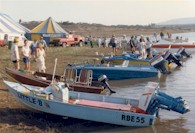
|
Rural people particularly in the Mpolweni catchment utilize the river extensively for recreation, drinking water (in places), fishing and for plant products from the riparian zone.
Good quality water used by forestry and agriculture, the latter especially just below Albert Falls Dam, in the eastern section and in parts of the Karkloof catchment.
Angling is very popular in this resource unit, not only in the two large dams, but also in the rivers (see p.33). Albert Falls has been considered one of the world's top bass dams.
The river carries water to Albert Falls and Nagle dams which are the main supply reservoirs for the greater Durban area, supplying more than 400 million litres of water per day for mainly domestic and industrial purposes. The river between the two dams carries water from Albert Falls dam, a storage reservoir, to Nagle dam, from where the water is piped to Durban.
|
| MANAGEMENT PRIORITIES
|
|
Define desirable river health below Midmar, Albert Falls damsand from this determine the amount, quality and flow pattern of water needed to maintain the river ecosystem so as to provide desired river-based goods and services (i.e the ecological Reserve).
Water demand management by agriculture and forestry and pollution control.
Minimise overgrazing in the iMpolweni district to reduce excessive sediment input to the river.
Minimise effluent pollution from the Howick area.
Accommodate the passage of young eels past dam walls.
|
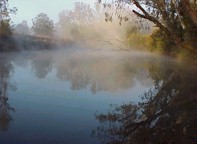
|
| EXTINCTION IN THE KARKLOOF RIVER
|
|
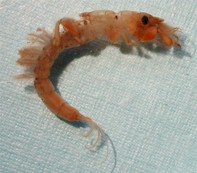
|
The Karkloof mist-belt forests, with their giant yellowwood trees, have over the years been heavily harvested and cleared for agriculture and plantation forestry. These magnificent forests, of which a few pristine patches still exist, were associated with streams of unquestionable quality and reliability. The upper reaches of the Karkloof River, were in the 1950s found to contain a rare burrowing mayfly, Ephemera mooiana, which has only ever been found here and in the Mooi River above Rosetta. In these rivers it burrowed into the hard mud banks beneath the water. Unfortunately, with the removal of indigenous forests and the conversion of the grasslands to agriculture, it appears that this species may now be extinct. An extensive search for this rare mayfly by a student from the University of Natal together with Umgeni Water, has proved fruitless.
|
| A RARE CRUSTACEAN OF THE UMNGENI RIVER
|
|
|
Potamonautes dentatus (left) is a river crab found in the uMngeni River, discovered here in 1992. This large species favours fast-running water and can sometimes be seen climbing the vertical cracks in the waterfall rocks at Albert Falls waterfall.
|
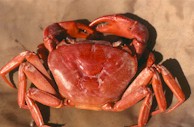
|
| A VERY RARE AQUATIC PLANT
|
|
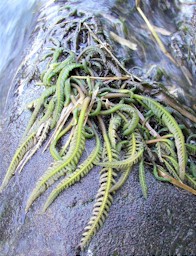
|
Hydrostachys polymorpha is a small fern-like plant that grows in fast currents, clinging to the rocky substrate of waterfalls and rapids. Hydrostachys is sensitive to changing temperatures (especially below dams) and excessive silt in the water. It is found fairly widely in the upper reaches of the uMngeni (especially the Karkloof tributary) and neighbouring rivers.
|
|
The reeds on the river between Midmar and Albert Falls Dams are often assumed to be Phragmites australis (syn.P.communis), but on careful study, have proved to be mostly the more tropical relative P. mauritianus which seems to have greater preference for oxygenated, faster flowing water than does P.australis [NOTE: P. australis is widespread in KZN, from Drankenensberg to coast, and is likely also to be present, but probably not admired].
|
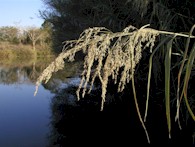
|
|